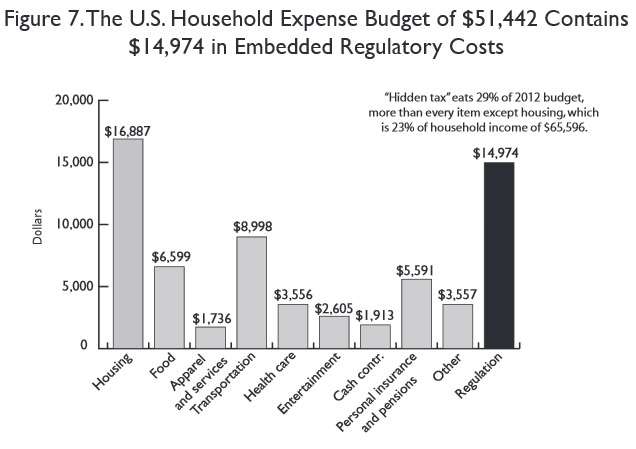The United States of Regulation: Compliance Costs Consume Huge Chunks of Our Economy


If the money spent in America on enforcing and complying with federal regulations was used instead to start a whole new country, this new country would be a major economic player on the world stage. So calculates Clyde Wayne Crews at the Competitive Enterprise Institute in his annual survey of the state of federal regulation, titled "Ten Thousand Commandments."
Though there's no easy way to quantify private regulatory costs because they're not the kind of things that show up on budgets, Crews calculates that Americans paid a grand total of $1.863 trillion in federal compliance costs for 2013. That's more money than the entire Gross Domestic Products of countries like Australia, Canada, and India.

Working through Bureau of Labor Statistics data calculating the number of households in America and an average household income of $65,000, Crews attempts to calculate how much of each family's budget is consumed by the cost of federal regulations, assuming logically that businesses pass the costs along to consumers. Crews acknowledge his attempted calculations aren't fully scientific, but he estimates that if the costs of regulation are completely passed through to consumers, each household pays nearly $15,000 a year in hidden regulatory costs. That's nearly a quarter of the average household income before taxes and higher than any other expense outside of housing.

Crews is only focusing on the costs of federal regulations, by the way. Imagine what additional burdens are faced by residents of high-regulation states like California and New Jersey.
Crews' report focuses a lot more on just these figures. There are all sorts of terrifying numbers in his 89-page report. Some highlights from his summary:
- This is the 21st edition of Ten Thousand Commandments. In that time, 87,282 final rules have been issued. That's more than 3,500 per year or about nine per day.
- The "Unconstitutionality Index" is the ratio of regulations issued by agencies compared to legislation passed by Congress and signed into law by the president. The ratio stood at 51 for 2013. That means there were 72 new laws and 3,659 new rules – 51 rules for every law, or a new rule every 2 ½ hours.
- The top six federal rulemaking agencies account for 49.3 percent of all federal rules. In 2013, these were the Departments of the Treasury, Commerce, Interior, Health and Human Services, and Transportation and the Environmental Protection Agency.
- Small businesses pay more in per-employee regulatory costs. Firms with fewer than 20 employees pay an average of $10,585 per employee, compared to $7,755 for those with 500 or more employees.
Read the full report here (pdf). Despite the length and subject matter, I find the report very accessible.


Show Comments (51)